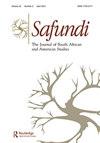Da struggle kontinues: Zulu love letter and the audiovisual language of a African counter cinema
IF 0.2
Q4 AREA STUDIES
Safundi-The Journal of South African and American Studies
Pub Date : 2020-10-30
DOI:10.1080/17533171.2020.1823739
引用次数: 1
Abstract
Zulu Love Letter (2005) was ahead of its time in terms of its disenchantment with the then vaunted idea of the “rainbow nation” (when South Africa was under the spell of Madiba Magic) and in its innovative cinematic aesthetic. Unlike films such as Forgiveness (2004), Red Dust (2004) and In My Country (2004) that dealt with matters related to the Truth and Reconciliation Commission (TRC), Zulu Love Letter questioned the grand narrative of the new South Africa and drew attention to the tensions between official projections of reconciliation and the continuing unfinished business of apartheid in the lives of the black women characters that are at the center of its narrative. Written by Bhekizizwe Peterson and directed by Ramadan Suleman, the film presents a black radical perspective on the problematics of forgetting and the lingering psychological trauma that apartheid inflicted on its victims. More importantly for me, the film has a distinctive aesthetic quality that is both sublime and political. In this essay, I will examine the audiovisual language of Zulu Love Letter with a particular focus on how the cinematography, editing and sound design work together to constitute, drawing on Peter Wollen,a subversive counter-cinema through a style that, in line with its thematic intentions, grapples with the visual, sonic and affective challenges related to the depiction and appreciation of trauma, memory and healing. Zulu Love Letter’s protagonist Thandeka Khumalo (Pamela Nomvete) is a journalist and woman who is at odds with post-1994 South Africa as she struggles to come to terms with her traumatic encounters during apartheid. The film not only centralizes black women but also chose a flawed and imperfected protagonist: she grapples with the performance of the patriarchal senses of femininity and motherhood demanded of her. Her strained relationship with her daughter Simangaliso and elderly parents gesture to the inter-generational and cultural strains within the black family/community and how these exceed the framing of reconciliation along racial lines. That notwithstanding, Thandeka is strong, resolute and unafraid to challenge the status quo. This layered depiction of black womanhood is uncommon in mainstream cinema (including South African cinema) which, more often than not, hegemonizes the experiences of male protagonists. Kenqu writes that Zulu Love Letter is a counter-cinema feminist text precisely because of the extraordinary ways it explores black womanhood. The counter-cinema elements can be read not only in the film’s its narrative content but also in its audiovisual form. Broadly speaking, counter-cinema aims to depart from达的斗争还在继续:祖鲁人的情书和一家非洲柜台电影院的视听语言
2005年的《祖鲁情书》(Zulu Love Letter)走在了时代的前面,它摒弃了“彩虹之国”(当时南非正处于“马迪巴魔法”(Madiba Magic)的魔咒之下)这一自吹自吹的观念,并采用了创新的电影美学。与《宽恕》(2004)、《红尘》(2004)和《在我的国家》(2004)等讲述真相与和解委员会(TRC)相关问题的电影不同,《祖鲁情书》质疑了新南非的宏大叙事,并将注意力集中在官方和解计划与黑人女性角色生活中未完成的种族隔离事业之间的紧张关系上,这些角色是叙事的中心。由贝奇兹维·彼得森(Bhekizizwe Peterson)编剧,拉马丹·苏莱曼(Ramadan Suleman)导演,这部电影以黑人激进的视角,展现了种族隔离给受害者带来的遗忘问题和挥之不去的心理创伤。对我来说更重要的是,这部电影有一种独特的美学品质,既崇高又政治性。在这篇文章中,我将研究《祖鲁情书》的视听语言,特别关注电影摄影、剪辑和声音设计是如何共同构成的,借鉴彼得·伍伦,一个颠覆性的反电影,通过一种风格,符合其主题意图,与视觉、声音和情感挑战有关的描述和欣赏创伤,记忆和愈合。《祖鲁情书》的主角桑德卡·库马洛(帕梅拉·诺维特饰)是一名记者,也是一名女性,她与1994年后的南非格格不入,因为她努力接受种族隔离时期的创伤遭遇。这部电影不仅集中了黑人女性,而且选择了一个有缺陷和不完美的主角:她努力表现女性的父权意识和母性意识。她与女儿Simangaliso和年迈的父母之间的紧张关系表明,黑人家庭/社区内的代际和文化紧张关系,以及这些关系如何超越了种族和解的框架。尽管如此,坦代卡是坚强、坚决和不怕挑战现状的。这种对黑人女性的分层描绘在主流电影(包括南非电影)中并不常见,主流电影往往将男性主角的经历视为霸权。肯曲认为《祖鲁情书》是一部反电影的女权主义作品,正是因为它以不同寻常的方式探讨了黑人女性。反电影元素不仅体现在影片的叙事内容上,也体现在影片的视听形式上。广义地说,反电影的目的是背离
本文章由计算机程序翻译,如有差异,请以英文原文为准。
求助全文
约1分钟内获得全文
求助全文
来源期刊
CiteScore
1.00
自引率
0.00%
发文量
0

 求助内容:
求助内容: 应助结果提醒方式:
应助结果提醒方式:


